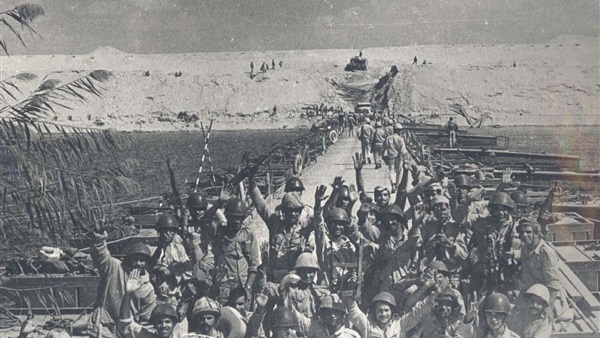The Egyptian army in the Muslim Brotherhood’s ideology

· The
Brotherhood’s plan to weaken the Egyptian and Syrian Armies after October victory
· The
Brotherhood Hatred of army forces… is their inheritance 78-year ago.
In light of the theoretical evidence for the
invalidity of the Brotherhood’s (1928) narrative on the concept of “homeland”,
the fundamental difference between the Muslim Brotherhood and the Egyptian army
has become apparent.
It is imperative that the soldier, according to the
doctrine of the Egyptian Army, to sacrifice his life for the home, so the Brotherhood
try to dismantle the army and create parallel secret entities.
Military Technical Academy &
the fighting Vanguard
The organization of Saleh Saraya targeted the Faculty
of Military Technical Academy in April 1974, and carried out an armed attack
against soldiers, killing 16 and wounding 65 soldiers.
The perpetrators of the attack were arrested: Saleh Saraya,
Talal al-Ansari, Karem Anatolia and Yahya Hashim. In the investigations, they
confessed that Zainab al-Ghazali, a prominent leader in the Muslim Brotherhood,
was the link between them and supreme guide of the Brotherhood.
In Al-Matareya
(east of Cairo), a group of young Islamists met at the end of the sixties,
inside a mosque, they were executed in 1966, after scheming to assassinate
Gamal Abdel Nasser.
In this mosque, the Palestinian-Jordanian, Saleh Saraya,
laid the foundation for the first armed jihadist organization in Egypt, which
was later known as the Military Technical Academy Organization, which carried
out the attack on the Military Technical Academy.
Saraya invoked the June 1967 war to revive the radicalism
activities and establishing the Islamic state. According to the confessions of Talal
al-Ansari, one of the elements, they follow the Brotherhood’s literature and Hassan
al-Hudaibi, (1951-1973).
At the end of the sixties, there were other meetings
at Al-Nuri Mosque in the Syrian city of Hama, led by Marwan Hadid, who was born
in Hama in 1934.
Marwan Hadid was a member of the Muslim Brotherhood
in the early 1950s. He traveled to Egypt and met Sayyid Qutb, then returned to
his country in 1964, and announced his intention to form an armed jihadist
group.
Hadid was influenced by the ideas of Qutb, which
made him the leader of a new line in the ranks of the Syrian Brotherhood. They
formed the nucleus of the so-called “fighting vanguard”, the first armed
jihadist experiment in Syria.
In 1968, Jordan witnessed the emergence of an armed
jihadist ideology that moved to Syria and Egypt in a relatively short period of
time.
In his confessions before the death sentence, Saraya
said he had planned to establish the military organization abroad, and then
returned to Egypt in 1971. It is likely that his time in Jordan saw the
planning of the militant jihadist thesis against the state and the ruler.
Although the Brotherhood denied any connection to
the organization of "military attack" which it considered a jihadist
and did not belong to the ideology of the Muslim Brotherhood, the documents
published by «WikiLeaks» published in 2013, revealed massages from the US
ambassador in Cairo to the US State Department, entitled «Communication between
the attacker of military technical academy and the Muslim Brotherhood, Stating
that there is one report confirming the connection of Saraya to the Brotherhood.
On the other hand, the ideas of the “fighting vanguard’s
commander” led him to the prison in March 1973, until he died in the military
prison in 1976.
Paradoxically, the same year saw the execution of
the leader of the “Military Technical Academy organization”.
The cells trained by Marwan Hadid vowed to avenge
him. Three years later, they carried out the biggest attack in the artillery
school.
The massacre of the "artillery school"
killed about 80 students and injured 54 others. The perpetrators of the attack
said that the attack left 250 dead, and was with the help of Captain
"Ibrahim al-Yusuf" belonging to the Muslim Brotherhood, which was an guard
officer on the day of the massacre.
The former Muslim Brotherhood leader in Syria, Ali
Sadr al-Din al-Bayanouni declared that Ibrahim al-Yusuf was not a member in the
brotherhood.
The Brotherhood's opinion on
visiting the Knesset
In the winter of 1977, the international news
agencies wrote about Ben-Gurion Airport's military reception to the late
Egyptian President Mohamed Anwar Sadat as a prelude to a visit to the Israeli
Knesset. “Peace in the Middle East is possible, but courageous leaders are
needed for it”
The Brotherhood saw the visit of Sadat to the
Israeli Knesset is a disgrace must be eliminated.
The secret of the only
celebration
The first anniversary of the October war by the
president of the Muslim Brotherhood, Mohamed Morsi was on the Cairo Stadium with
the presence of his supporters from the group.
The ceremony started with cheers from young men
wearing the Muslim Brotherhood's logo, chanting Allah Akber at the moment when
Morsi enters the stadium. The ceremony is marked by the absence of Marshal
Mohammed Hussein Tantawi, commander of the 16th Infantry Regiment in the
October War.
Lieutenant General Sami Annan, the chief of staff of
the armed forces was also absent.
While Tantawi and Annan missed the 39th anniversary
of victory, a group of Islamic movement figures convicted of killing Sadat,
among them Tariq al-Zumur, leader of the Islamic Group, were present, sparking
popular anger among the Egyptians.
The Brotherhood believes that the army is the
biggest obstacle facing the group's ambitions in ruling Egypt to control the
rest of the Arab countries. They thought they have the ability to regain their
popularity if they succeed in overthrowing the army or dividing it.
Ayat Arabi incites against the Egyptian army, in
conjunction with the commemoration of the sixth of October each year. She
described the victory of the army in its war against Israel as
"defeat" and said that there is no difference between the 1967
setback and the Egyptian war to liberate Sinai.





